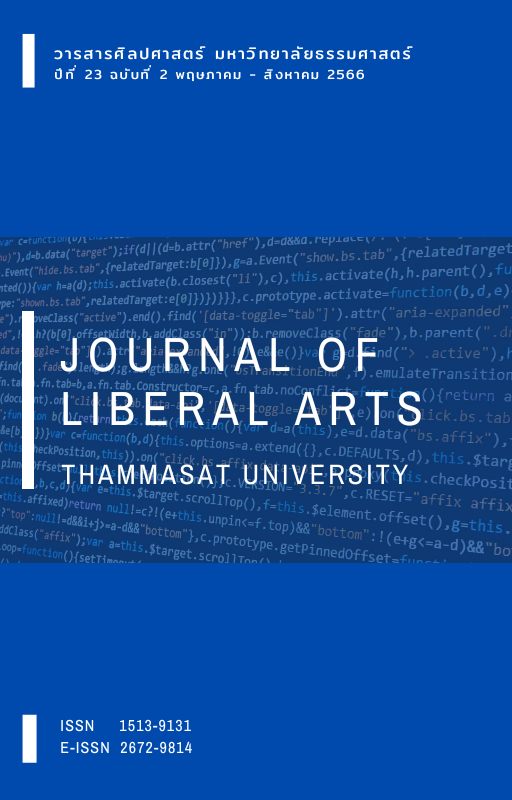Conceptual Metaphor of the Word ‘Caj’ (mind) in Buddhism
Main Article Content
Abstract
The purpose of this article is to study the conceptual metaphor of the word ‘Caj’ (mind) in Buddhism with a cognitive linguistics approach. The data were collected from the Royal Thai Tripitaka version of 1971: Vinaya Pitaka, Sutta Pitaka, and Abhidhamma Pitaka, containing a total of 45 books. The study reveals that the word ‘Caj’ reflects seven conceptual metaphors: [MIND IS AN OBJECT], [MIND IS SPACE], [MIND IS A PERSON], [MIND IS NATURE], [MIND IS AN ANIMAL], [MIND IS FIRE], and [MIND IS FOOD]. These metaphors reflect Buddhist thoughts and beliefs that the mind is not only abstract but also concrete.
Downloads
Article Details

This work is licensed under a Creative Commons Attribution-NonCommercial-NoDerivatives 4.0 International License.
References
กรมศาสนา. (2514). พระไตรปิฎกภาษาไทยฉบับหลวง. https://www.thepathofpurity.com/home/พระไตรป-ฎก-pdf/แปล-๔๕-เล-ม-ฉบ-บหลวง/
คยอง อึน ปาร์ค. (2558). มโนทัศน์ของคำว่า ใจ ในภาษาไทยเปรียบเทียบกับภาษาเกาหลี.วารสารศิลปศาสตร์, 15(2), 199-212.
ภัทรา พิเชษฐศิลป์. (2556). มโนทัศน์ของ “XIN” ในภาษาจีนและ “ ใจ” ในภาษาไทยการศึกษาตามแนวอรรถศาสตร์ปริชาน. [วิทยานิพนธ์ปริญญาดุษฎีบัณฑิต, จุฬาลงกรณ์มหาวิทยาลัย]. Chulalongkorn University Intellectual Repository.
ราชบัณฑิตยสถาน. (2554). พจนานุกรมฉบับราชบัณฑิตสถาน พ.ศ. 2554. http://www.royin.go.th/dictionary/
สนิท ศรีสำแดง. (2544). ปรัชญาเถรวาท. โรงพิมพ์แห่งมหาจุฬาลงกรณราชวิทยาลัย.
สุกัญญา รุ่งแจ้ง. (2548). อุปลักษณ์เชิงมโนทัศน์ของการใช้คำว่า “ใจ” ในภาษาไทย. [วิทยานิพนธ์ปริญญามหาบัณฑิต, มหาวิทยาลัยธรรมศาสตร์]. Thammasat University Digital Collections.
Evans, V. (2004). The structure of time: Language, meaning and temporal cognition. John Benjamins.
Evans, V. (2007). A glossary of cognitive linguistics. Edinburgh University Press.
Evans, V., & Green, M. (2006). Cognitive linguistics: An introduction. Edinburgh University Press.
Gibbs, R. (1994). The poetics of minds: Figurative thought, language, and understanding. Cambridge University Press.
Johnson, M. (1987). The body in the mind: The bodily basis of meaning, imagination, and reason. Chicago University Press.
Kövecses, Z. (2002). Metaphor: A practical introduction. Oxford University Press.
Kövecses, Z. (2010). Metaphor: A practical introduction (2nd ed.). Oxford University Press.
Lakoff, G., & Johnson, M. (1980). Metaphors we live by. The University of Chicago Press.
Pragglejaz, G. (2007). MIP: A method for identifying metaphorically used words in discourse. Metaphor and symbol, 22(1), 1-39.
Sharifian, F. (2008). Conceptualizations of del ‘heart-stomach’ in Persian. In F. Sharifian, R. Dirven, N. Yu, & S. Niemeier (Eds.), Body, Culture, and Language: Conceptualisations of heart and other internal body organs across languages and cultures (pp. 247-265). Mouton de Gruyter.
Yu, N. (2009). The Chinese heart in a cognitive perspective: Culture, body and language. Mouton de Gruyter.

